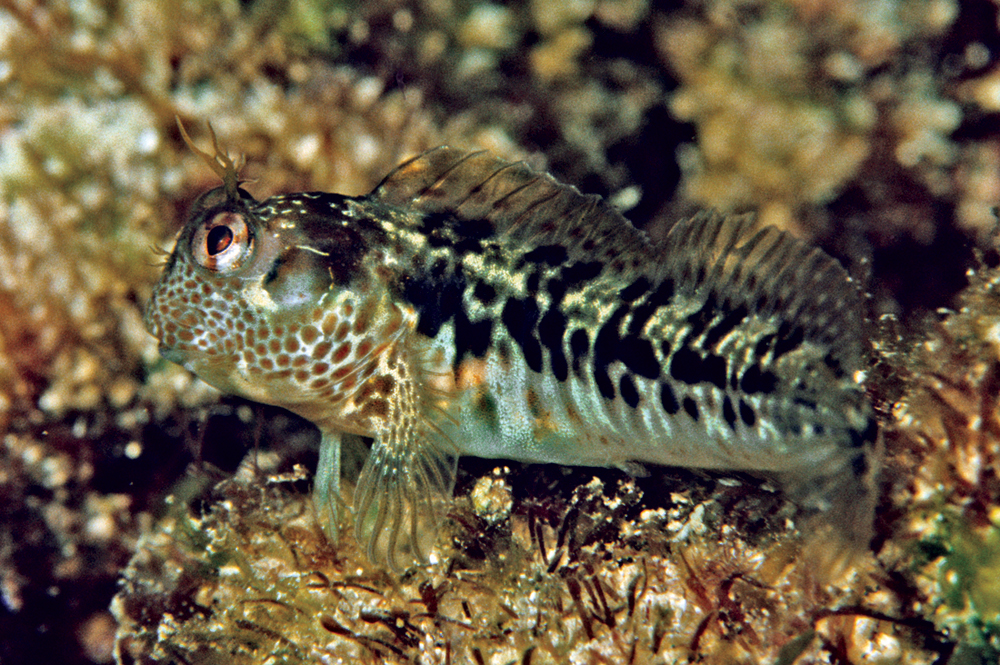- Classification
- ACTINOPTERYGII
- PERCIFORMES
- BLENNIIDAE
- Parablennius
- postoculomaculatus
False Tasmanian Blenny, Parablennius postoculomaculatus Bath & Hutchins 1986

A False Tasmanian Blenny, Parablennius postoculomaculatus. Source: Barry Hutchins / Western Australian Museum. License: All rights reserved
Summary:
A greenish-grey to pale orange blenny with many dark spots that are sometimes grouped into saddle-like, oval or round blotches interspersed with a brick-red spot, a large pale-edged brown spot behind the eye, and reddish-brown spots on the head and pectoral-fin base. Males have a dark spot on the fin membrane between the first and second dorsal-fin spines.
Cite this page as:
Bray, D.J. 2020, Parablennius postoculomaculatus in Fishes of Australia, accessed 06 Jul 2025, https://fishesofaustralia.net.au/home/species/1081
False Tasmanian Blenny, Parablennius postoculomaculatus Bath & Hutchins 1986
More Info
|
Distribution |
Endemic to Western Australia from Two Peoples Bay in the south, to the Murion Islands just north of Exmouth Gulf. Inhabits hard substrates in rocky areas and coastal bays, from the intertidal region to a depth of 10 m - often on jetty pylons. |
|
Features |
Dorsal fin XII, 15-`7; Anal fin II, 16-18. Supraorbital tentacle - long, stout main tentacle with 3-9 side branches; head lateral line system with 120 to 266 pores. |
|
Colour |
Male with intense spotting on lower side of head, a round pale-edged brown blotch on the postorbital region; numerous medium to blackish brown blotches on lower half of cheek, sides of upper lip, suborbital area, branchiostegal membranes, pectoral fin base and basal third of pectoral fin; 6 to 7 groups of elongate rows of dark blotches on upper 2/3 of body. |
|
Species Citation |
Parablennius tasmanianus postoculomaculatus Bath & Hutchins 1986, Senckenbergiana Biologica 66(4/6): 187, figs 24-28. Type locality: Beacon Islands, Houtman Abrolhos, Western Australia. |
|
Author |
Bray, D.J. 2020 |
|
Resources |
False Tasmanian Blenny, Parablennius postoculomaculatus Bath & Hutchins 1986
References
Bath, H. 1989. Eine weitere Unterart von Parablennius tasmanianus (Richardson 1849) (Pisces: Blenniidae). Senckenbergiana Biologica 69(4/6): 293-300 (as Parablennius tasmanianus postoculomaculatus)
Bath, H. 1996. Beitrag zur Osteologie der Arten der Tribus Parablenniini. Die Beziehungen der Knochen des Schädeldaches zum Seitenorgan-System und zu den Weichteilbildungen der Kopfoberseite sowie die systematische Bedeutung der Befunde nebst Bemerkungen. Senckenbergiana Biologica 76(1/2): 65-92 (as Parablennius tasmanianus postoculomaculatus)
Bath, H. 2008. Review of the genus Parablennius Miranda-Ribeiro from Australia and New Caledonia (Pisces: Blenniidae: Salariinae). Stuttgarter Beiträge zur Naturkunde. Serie A (Biologie) Neue Serie 1: 77-94
Bath, H. & Hutchins, B. 1986. Die Blenniini des australischen Raums und Neuseelands mit Beschreibung einer neuen Art und einer neuen Unterart. Senckenbergiana Biologica 66(4/6): 167-213 figs 1-47 (as Parablennius tasmanianus postoculomaculatus)
Hoschke, A., Whisson, G. & Moore, G.I. 2019. Complete list of fishes from Rottnest Island. pp. 150-161, in Whisson, G. & Hoschke, A. (eds) The Rottnest Island fish book. 2nd ed. Perth : Aqua Research and Monitoring Services.
Hutchins, J.B. 1994. A survey of the nearshore reef fish fauna of Western Australia's west and south coasts — The Leeuwin Province. Records of the Western Australian Museum, Supplement 46: 1-66 figs 1-6
Hutchins, J.B. & Thompson, M. 1983. The Marine and Estuarine Fishes of South-western Australia. Perth : Western Australian Museum 103 pp. 345 figs. (as Parablennius sp.)
Smith-Vaniz, W.F. 2008. Family Blenniidae. pp. 693-696 in Gomon, M.F., Bray, D.J. & Kuiter, R.H. (eds) Fishes of Australia's Southern Coast. Sydney : Reed New Holland 928 pp.
Williams, J.T. 2014. Parablennius postoculomaculatus. The IUCN Red List of Threatened Species 2014: e.T48342455A48353130. http://dx.doi.org/10.2305/IUCN.UK.2014-3.RLTS.T48342455A48353130.en. Downloaded on 24 May 2019.






